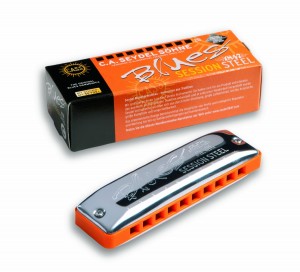
I’m Liking the Seydel Session Steel
Last August at SPAH I bought a Seydel Session Steel harmonica in the key of A from Rupert Oysler. Since then I’ve been playing that instrument frequently and hard, and it still plays and sounds pretty much the way it did when I took it out of the case for the first time. That makes it the most durable instrument I’ve ever owned, not to mention louder, punchier, more responsive, and more generally playable than the vast majority of the harps in my collection.
I just took delivery on three more Session Steels in Bb, C, and D, and I’m looking forward to putting them through their paces. If they’re up to the standard set by the A harp, I’ll be very impressed. These harps aren’t exactly cheap, but they’re certainly price and performance competitive with the Hohner MB Deluxe and Crossover, Suzuki Manji and Olive, etc., and so far they seem to be more durable than any of the similarly-priced competition. (Certainly my MB Deluxes and Manjis don’t hold up under hard playing the way my A Session Steel does.) Stay tuned for more commentary as I work with my new Session Steels.

Related Posts
3 Comments
Leave a Reply
You must be logged in to post a comment.
WHAT’S NEW
Categories
- Audio/Video
- Blog
- Blue Future
- Digitech RP Tricks and Tips
- Discography, CDs, Projects, Info, Notes
- Featured Video
- For the Beginner
- Gallery
- Hunter's Effects
- Hunter's Music
- Huntersounds for Fender Mustang
- Meet the Pros
- More Video
- MPH: Maw/Preston/Hunter
- My Three Big Contributions
- Player's Resources
- Pro Tips & Techniques
- Recommended Artists & Recordings
- Recommended Gear
- Recorded Performances
- Reviews, Interviews, Testimonials
- The Lucky One
- Uncategorized
- Upcoming Performances
- Zoom G3 Tips and Tricks

I’m happy you’re impressed. I’ve been playing a Seydel Noble in C for a while, and it’s just about perfect. I then got a Session Steel in D (the first harp I’ve had above C, and have to say I’m a bit underwhelmed. Despite gentle treatment, warming up before playing, and a fair amount of careful tweaking, it has horrific torsional squeals on the 6 and 7 overblows. Yes, it could be my technique, not having played a (slightly) high harp before. But I’m aware of that, and have worked hard on it, and ultimately I’m disappointed. I’ve not tried nail varnish etc yet (I’ve had it for a couple of months), but I’d kinda expect that would be unnecessary, for the non-trivial price.
Sure, it seems durable. Playing blues, it sounds bright, and feels responsive. It’s pretty air-tight, but not astonishingly so. Comparing it with the Noble, the latter has some kind of tip-scooping, while the Session doesn’t. The Noble overblows are superbly responsive. Both harps feel a bit different from brass-reeded harps — slightly more temperamental, somehow.
I’m going to try a Session Steel low F sometime. I’m prepared to believe that they’re good instruments in lower keys, but I doubt I’d buy another high key Session Steel.
I might mention that it’s not easy to put the cover plates on again in exactly the right position. (The Session Steel uses different reed plates from the Noble — the Session’s sit recessed in the comb. They seem very well constructed and well tuned, without the savage gouging one sometimes sees on Hohner harp reeds.)
Good luck with your new harps. Let us know what you think.
Hank, I just got a Noble in the key of “C” and love it. Because the Nobel’s comb is thinner, and the holes are slightly different size/shape, I think there is a little difference in the way it plays compared to it’s siblings (silver and classic). I’ve never had a Session Steel, but I own several 1847 Silvers and have worked on the reeds. Stainless reeds don’t sound that much different than brass ones, but they sure are different when it comes to any tuning, gapping, etc. A few things to keep in mind when working with Seydel’s stainless steel reeds: 1. Use a dremel tool for tuning (it will take all day with a scraper or file), and stay away from all edges of the reed. 2. When gapping or shaping the reed profile, it is VERY important that you support the reed in a manner that ensures that any flexing is spread out over the reed’s entire length (or nearly so). If they flex too far within a small area (especially on the rivet end), they are very prone to cracking (despite claims that stainless reeds are so durable) 3. Because stainless steel is much harder than brass, the reeds will “swivel” on the rivet somewhat easier than brass reeds, so they can easily become misaligned with the slot, just enough for them to still play, but not sound quite right. 4. 1847’s use self-tapping screws to hold the reed-plates together – they wear out and strip out easily, so don’t overtighten them, and if you install new reed-plates, order new screws and install them as well. B.T.W. … “P.T. valving” will turn the 1847 into the loudest harp you’ve ever heard (although the valves can stick and cause problems, and are not for everyone – myself included).
Hi Hank,
After working with the Session Steels, I’m enjoying the C and lower keys more than the D and higher. The A and Bb are very nice instruments indeed; the C is not quite as responsive, but very playable. The D seems a little tight and squeaky. I may try gapping it to see what that does. In any case, your comments seem on-target.